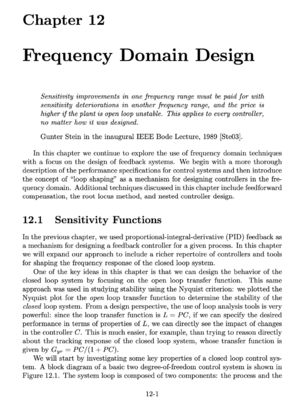Difference between revisions of "Frequency Domain Design"
Jump to navigation
Jump to search
| Line 1: | Line 1: | ||
{{Chapter | {{Chapter | ||
|Chapter number=12 | |Chapter number=12 | ||
| + | |Short name=loopsyn | ||
|Previous chapter=PID Control | |Previous chapter=PID Control | ||
|Next chapter=Robust Performance | |Next chapter=Robust Performance | ||
Revision as of 05:49, 28 December 2020
| Prev: PID Control | Chapter 12 - Frequency Domain Design | Next: Robust Performance |
In this chapter we continue to explore the use of frequency domain techniques with a focus on the design of feedback systems. We begin with a more thorough description of the performance specifications for control systems and then introduce the concept of “loop shaping” as a mechanism for designing controllers in the fre- quency domain. Additional techniques discussed in this chapter include feedforward compensation, the root locus method, and nested controller design.
Contents
- Sensitivity Functions
- Performance Specifications
- Response to Reference Signals
- Response to Load Disturbances and Measurement Noise
- Measuring Specifications
- Feedback Design via Loop Shaping
- Design Considerations
- Lead and Lag Compensation
- Feedforward Design
- Combining Feedforward and Feedback
- Difficulties with Feedforward
- Approximate Inverses
- The Root Locus Method
- Design Example
- Further Reading
- Exercises
